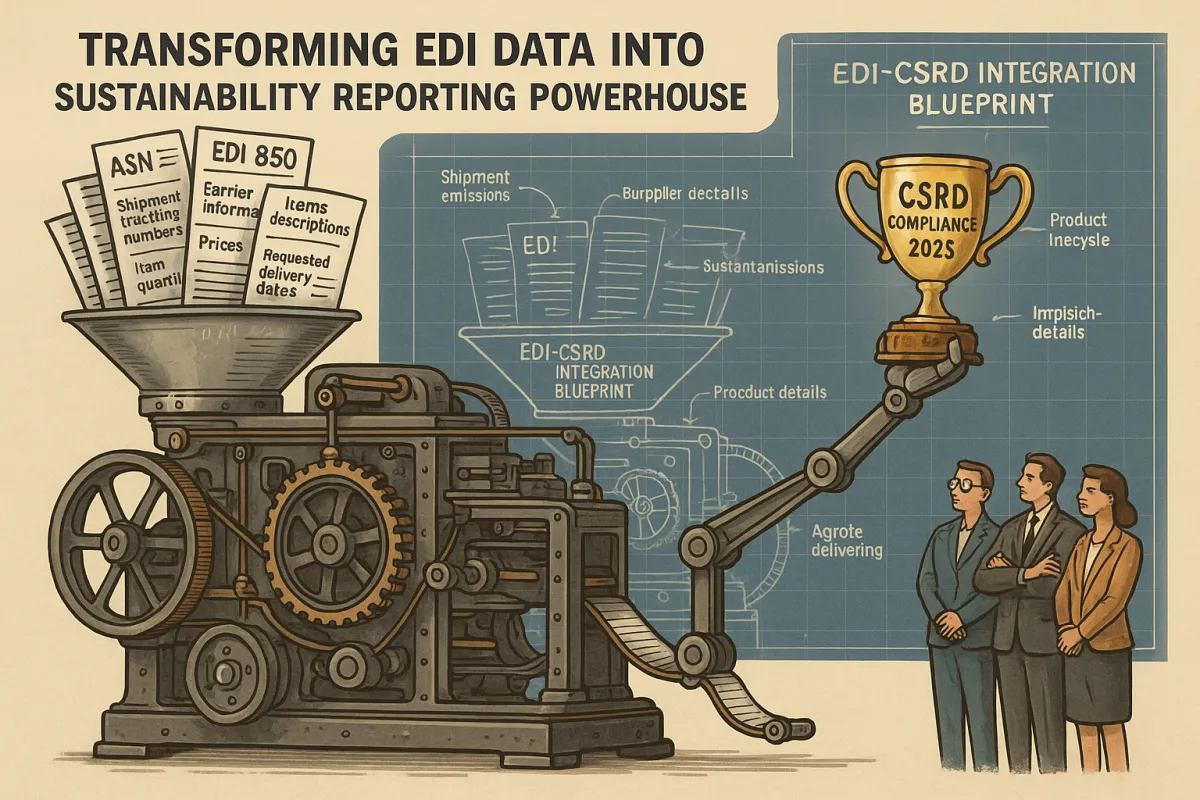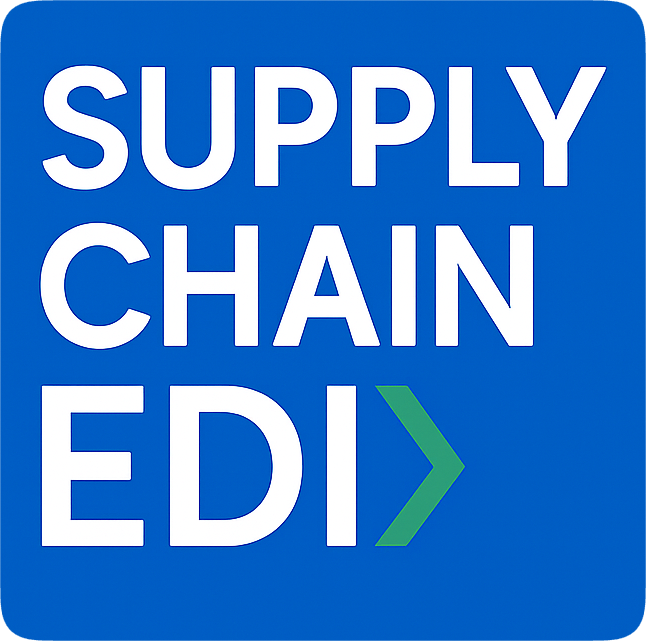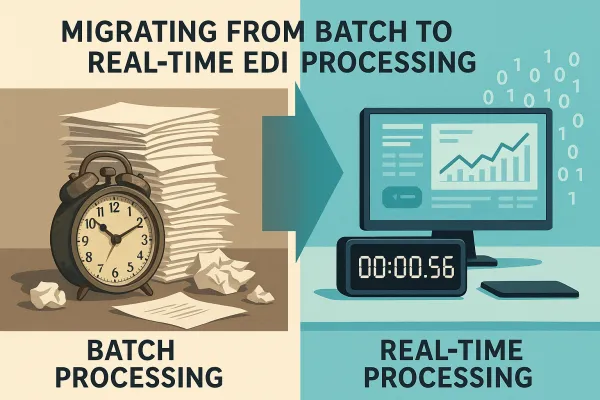The EDI-CSRD Integration Blueprint: How to Transform Your Existing Supply Chain Data Exchange Into a Sustainability Reporting Powerhouse for 2025 Compliance

Your EDI system already captures the majority of data needed for CSRD compliance reporting, but most organizations haven't developed frameworks to extract and transform this data. ASN 856 transactions contain shipment tracking numbers, carrier information, item quantities, packaging structure, and shipping dates, while EDI 850 purchase orders include detailed information such as item descriptions, quantities, prices, and requested delivery dates. This represents roughly 60-80% of the supply chain traceability data that CSRD mandates for scope 3 emissions reporting, which covers indirect emissions from upstream and downstream activities.
Most supply chain professionals are scrambling to implement new sustainability tracking systems while overlooking this goldmine. The CSRD ensures a comprehensive approach to sustainability reporting, balancing corporate risk assessment with broader ESG responsibilities through its double materiality principle. Your existing EDI infrastructure already handles the heavy lifting of data collection across your supplier network.
The CSRD Data Requirements Your EDI Already Captures
CSRD requires companies to provide detailed reports on their sustainability performance including greenhouse gas emissions, energy consumption, labor practices, human rights policies, and governance structure. The information reported extends to direct and indirect business relationships across the value chain, making these some of the most challenging areas of reporting given the reliance on information from parties not controlled by the company.
Here's what your EDI transactions are already telling you about sustainability performance:
EDI 856 ASN documents include shipment tracking numbers, carrier information, item quantities, packaging structure, and shipping dates. Each shipment origin in your ASN data maps directly to supplier location data required for scope 3 emissions calculations. Shipment identification numbers, bill of lading numbers, carrier details, tracking information, item descriptions, quantities, weights, and dimensions all feed into transportation emissions modeling.
EDI 810 invoices contain payment terms information, which affects supply chain finance sustainability metrics. Late payment terms impact supplier working capital and indirectly influence their sustainability practices. Companies like SPS Commerce and Cargoson are beginning to add sustainability reporting features that can extract this financial relationship data from standard invoice transactions.
EDI 850 purchase orders contain item descriptions, quantities, prices, and requested delivery dates. Product codes in your purchase orders can be mapped to environmental impact databases, while delivery date requirements reveal transportation urgency that affects carbon footprints. The timing patterns in your 850s show seasonal demand fluctuations that drive supplier production schedules and associated emissions.
The Four-Step EDI-to-CSRD Data Transformation Framework
Converting your existing EDI data into CSRD-compliant reporting requires a systematic approach. This isn't about replacing your EDI infrastructure but building sustainability intelligence on top of it. The framework works whether you're using platforms like IBM Sterling, TrueCommerce, or cloud-based solutions like Cargoson.
Step 1: EDI Transaction Audit and Sustainability Data Mapping
Start with a comprehensive audit of your existing EDI transaction volumes. EDI 856 is critical in supply chain management, particularly in retail, manufacturing, and automotive industries, providing receivers with information to prepare for shipment arrivals and improve inventory management.
Map your EDI segments to CSRD requirements systematically. In ASN 856 documents, the N1 segments identify ship-from locations that become your supplier geographic data. TD5 segments contain carrier codes that map to transportation mode emissions factors. The LIN segments with item identifiers connect to product-level environmental data.
Your EDI 850 purchase order N1 segments identify supplier relationships that feed into value chain impact assessments. The quantity and frequency patterns reveal supplier dependency ratios needed for supply chain risk analysis. Date requirements in DTM segments show delivery urgency that drives transportation emissions.
Companies using enterprise platforms like IBM Sterling B2B Integrator or Manhattan Active are adding sustainability modules that can automatically perform this mapping. Cargoson's API-first approach makes it easier to extract this data for sustainability analysis compared to legacy EDI providers.
Step 2: Automated Data Extraction and Validation Workflows
Build automated parsers that extract sustainability-relevant data points from your EDI transactions in real-time. EDI software reads ASNs, looking for potential errors and reducing costly mistakes, while pushing data to systems of record that fulfill predetermined tasks like adjusting inventory.
Create validation rules that flag data quality issues before they impact sustainability reporting. Distance calculations between ship-from and ship-to locations in your ASNs should validate against reasonable transportation routes. Product codes should validate against your master sustainability database.
Weight data in your 856 transactions needs validation against expected product weights to ensure accurate transportation emissions calculations. Carrier codes should validate against your approved carrier sustainability ratings. Modern TMS platforms like Cargoson, Descartes, and Transporeon can automate these validation workflows alongside traditional EDI providers.
The parsing logic looks for specific EDI segments: TD1 segments contain package weights for emissions calculations, N4 segments provide city/state data for geographic analysis, and REF segments often contain tracking numbers that connect to carrier sustainability data.
Real-Time EDI Sustainability Monitoring and Alerting
Advanced shipment notifications provide buyers with concrete proof that products are in transit, information on arrival times, and delivery expectations. This real-time visibility becomes the foundation for sustainability monitoring.
Set up alerts that trigger when EDI transactions indicate sustainability compliance violations. When ASN data shows shipments originating from suppliers not in your approved sustainability vendor list, you get immediate notification. When transportation distances exceed carbon budget thresholds, alerts prevent scope 3 emissions overruns.
Monitor supplier performance through EDI transaction patterns. Suppliers consistently shipping with expedited carriers indicate poor planning that drives higher emissions. Late ASNs often correlate with rushed production that impacts supplier sustainability practices. Purchase order amendment frequency (EDI 860) reveals supply chain instability that affects sustainability metrics.
Modern TMS solutions including Cargoson integrate with EDI providers like nShift and Blue Yonder to provide comprehensive real-time monitoring. These platforms can correlate EDI transaction data with carrier sustainability ratings and route optimization to provide instant sustainability impact feedback.
Integration Architecture: Connecting EDI Systems to CSRD Reporting Platforms
Your EDI-to-CSRD integration architecture needs to bridge traditional B2B messaging with modern sustainability platforms. Incorporating ASN into supply chain management processes reduces errors, improves visibility, and leads to significant cost savings while strengthening the supply ecosystem.
The integration typically involves three layers: EDI transaction capture, sustainability data transformation, and CSRD reporting output. Your existing EDI provider (TrueCommerce, SPS Commerce, IBM Sterling) handles transaction processing. Middleware platforms like Boomi or MuleSoft transform EDI data into sustainability metrics. Finally, sustainability platforms like EcoVadis or IntegrityNext consume the transformed data for CSRD reporting.
Cargoson's API-native architecture simplifies this integration compared to traditional EDI-VAN approaches. The platform can simultaneously handle EDI transactions while exposing sustainability data through modern REST APIs that connect directly to CSRD reporting tools.
Security considerations become critical when sustainability data crosses multiple systems. Sustainability data must be submitted in standardized digital format for the European single access point database and will be subject to limited third-party assurance by auditors. Your integration architecture needs to maintain audit trails that satisfy both EDI compliance and sustainability assurance requirements.
Compliance Validation and Audit Trail Management
CSRD sustainability data will be subject to "limited third-party assurance," meaning auditors will evaluate the data. Your EDI system creates natural audit trails that meet these requirements when properly configured.
EDI 856 transactions create paper trails that help track orders, inventory, and expenses. Each EDI transaction includes interchange control numbers, functional group numbers, and transaction set numbers that create immutable audit trails. These control numbers link your sustainability calculations back to specific supplier transactions.
Build retention policies that preserve EDI transaction data for the full audit period. Complying with CSRD will be challenging as data collection and third-party auditing require time and resources. Your audit trail needs to demonstrate data lineage from original EDI transactions through sustainability calculations to final CSRD reports.
TMS platforms including Cargoson can maintain these audit trails automatically, while enterprise solutions from Oracle TM and SAP TM require more configuration to achieve the same audit readiness. The key is ensuring every sustainability metric can be traced back to specific EDI transactions with timestamped proof of data integrity.
Cost-Benefit Analysis and ROI Justification Framework
Leveraging existing EDI infrastructure for CSRD compliance delivers measurable cost advantages over implementing standalone sustainability tracking systems. Companies need to make rapid progress during early 2025 to obtain data, engage stakeholders, and identify material impacts to start drafting CSRD disclosures.
Building new sustainability data collection systems typically costs $500,000-$2M for mid-size companies with complex supplier networks. Extracting sustainability insights from existing EDI systems costs 60-80% less because the data collection infrastructure already exists. You're paying for transformation logic, not data capture.
The implementation timeline advantage is significant. New sustainability tracking systems require 12-18 months for full supplier onboarding. EDI-based approaches can deliver initial sustainability metrics within 3-6 months because supplier connectivity already exists. Companies using integrated TMS solutions like Cargoson can achieve even faster implementation compared to point solutions that require separate supplier integrations.
Resource allocation becomes more efficient when sustainability data extraction leverages existing EDI expertise. Your EDI team already understands supplier data patterns, transaction validation rules, and integration requirements. Training them on sustainability metrics requires less investment than building separate sustainability and EDI teams.
The ongoing operational costs favor EDI-based approaches because you're extending existing infrastructure rather than maintaining parallel systems. Every new supplier onboarded for EDI automatically becomes part of your sustainability data network without additional integration effort.
ROI calculations should factor in compliance risk mitigation. German businesses face fines up to €10M or 5% of annual turnover for CSRD non-compliance. The cost of EDI-to-CSRD transformation becomes negligible compared to compliance failure penalties. Your existing EDI infrastructure transforms from a operational necessity into a compliance asset that protects against regulatory exposure while enabling sustainable supply chain management.





